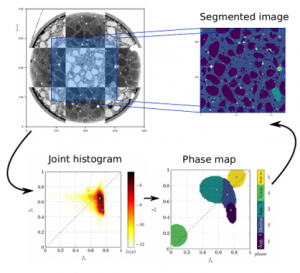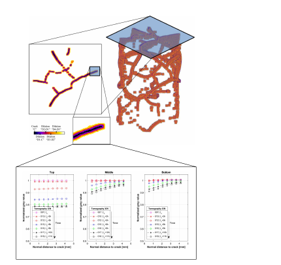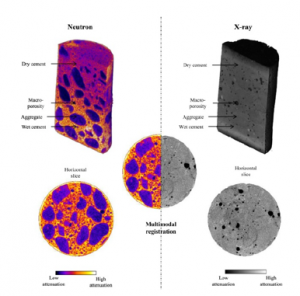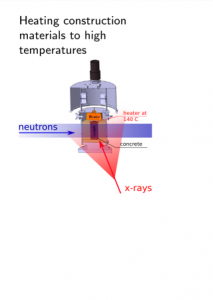Alessandro Tengattini, an instrument scientist at the Institut Laue-Langevin (ILL), discusses research aimed at creating longer-lasting concrete for greener infrastructure
Concrete is the most ubiquitous building material on Earth, and we are producing so much of it that soon it will outweigh all living matter on the planet.
 Our reliance on concrete is not going anywhere soon, as this fundamental material has been around since Roman times and forms the basis of all infrastructure in all urban areas worldwide. While concrete has proved an incredibly useful and versatile tool for construction, it requires rethinking to better frame it in a greener and more sustainable future.
Our reliance on concrete is not going anywhere soon, as this fundamental material has been around since Roman times and forms the basis of all infrastructure in all urban areas worldwide. While concrete has proved an incredibly useful and versatile tool for construction, it requires rethinking to better frame it in a greener and more sustainable future.
Concrete production is linked to approximately 8%-10% of all CO2 emissions annually, more than the impact of burning aviation fuel, and only just behind global agriculture. As demand for urbanisation and construction only sets to increase the rate of concrete production, something must be done.
Research is helping to explore the inner workings of concrete
Developing greener and longer-lasting concrete is key to this transformation, and scientists at the Institut Laue-Langevin (ILL) in Grenoble are laying the foundations for this change. At the world’s flagship centre for neutron science, researchers can explore the inner workings of materials to better understand opportunities to improve them for use.
The research was conducted using NeXT-Grenoble (Neutron and X-ray Tomography in Grenoble), a world-leading collaboration between ILL and Universite Grenoble Alpes to develop state-of-the-art methods for investigating materials, NeXT-Grenoble is an imaging instrument that can provide highly accurate 3D models from neutron diffraction, and is just one of the many instruments we use at ILL to support material analysis.
Neutrons, a specific type of subatomic particle, are incredibly useful for detecting the presence of hydrogen atoms in samples, and those hydrogen atoms often suggest the presence of water.
Concrete hydration and drying can lead to structure failure
 A crucial role in concrete degradation is played by moisture. Concrete hydration and drying can lead to cracking and then slowly diminish the integrity of the overall concrete object. This can have an especially significant impact on reinforced concrete as the metal rods within the concrete are exposed to the elements leading to corrosion. By analysing the presence, structure and movement of water molecules within different types of concrete, we can determine the most resistant and the vulnerable concrete microstructures. The NeXT-Grenoble instrument provides a 3D image of the sample, and this is then corroborated with simultaneous X-ray tomography, as the experiment continues, we can view a snapshot of the changes occurring over time.
A crucial role in concrete degradation is played by moisture. Concrete hydration and drying can lead to cracking and then slowly diminish the integrity of the overall concrete object. This can have an especially significant impact on reinforced concrete as the metal rods within the concrete are exposed to the elements leading to corrosion. By analysing the presence, structure and movement of water molecules within different types of concrete, we can determine the most resistant and the vulnerable concrete microstructures. The NeXT-Grenoble instrument provides a 3D image of the sample, and this is then corroborated with simultaneous X-ray tomography, as the experiment continues, we can view a snapshot of the changes occurring over time.
Where cracks are formed, there is an immediate local acceleration of the drying process and therefore an artificially advanced ageing and degradation process takes place. The presence of water, coupled with changes in temperature, reflects the natural conditions external concrete structures face. This reflection of natural conditions and analysis of how cracks expand in concrete was central to our research aim to better model and understand the processes that make concrete weaker over time. Our project is one of the first in the world to measure the impact of moisture on concrete in this way.
With a solid foundation of data underneath it, the production of concrete can be iterated and improved. Longer-lasting concretes can be developed, the process for concrete production can be perfected and the lifespan of our infrastructure can be increased. While this may seem like a piecemeal change to the problem of decarbonising urban infrastructure, the repercussions are significant. If a concrete structure can have its life extended by 30% then that will result in a huge carbon emission saving across its lifespan, and that saving can be shared across all buildings made from it – the most common of all building materials.
Structures need to become more resilient to endure the impacts of climate change
As our planet grapples with the increasingly severe impacts of global climate change, our structures will need to become more resilient and more resistant to the forces of mother nature. With more extreme weather comes more moisture and more heat, degrading more quickly the materials we already have. To futureproof our built environment, materials must be improved to withstand more varied climates over the years.
Already plans are in place for large concrete manufacturers, like LafargeHolcim, a key collaborator on this project, to begin using neutron-derived research to inform their concrete production in the short-medium term. If we are to become serious about decarbonising the construction industry, we must realise that every small change can have far-reaching consequences and every percentage point of carbon savings in concrete production will heavily impact the human footprint on the planet.
Alessandro Tengattini
Instrument scientist
Institut Laue-Langevin

















